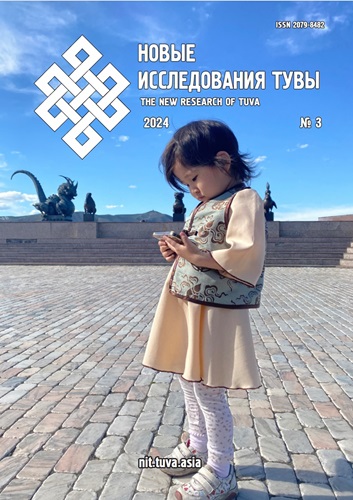Psychological problems in adolescents of the Republic of Tuva with different types of online behavior
DOI:
https://doi.org/10.25178/nit.2024.3.7Keywords:
Republic of Tuva; teenager; Tuvans; Russians; online behavior; internet addictionAbstract
The article analyzes the psychological problems of adolescents with different online behaviors in the Republic of Tuva. It is based on the results of two psychological surveys conducted by the author in April and May of 2022 and 2023, respectively, in the republic. A total of 265 participants (173 Tuvan and 92 Russian) were surveyed. The screening questionnaire “Strengths and Difficulties” by R. Goodman was used for this study.
For all surveyed adolescents, an increase in psychological problems was found to be an undesirable sign of Internet addiction. Dominant psychological issues have been identified among adolescents with similar online behaviors, depending on ethnic, gender, and age differences.
The most prevalent psychological problems among Tuvan adolescents were communication issues with peers (23.1–42.4%). Additionally, psychological issues related to the age group were also communication problems with peers, occurring 2 to 2.5 times more frequently (36.6–43.2%) among adolescents aged 12–14 with adaptive and maladaptive internet use.
When differentiating by gender, girls with maladaptive internet use do not exhibit the best indicators compared to boys in the same group. Emotional disorders are 2.2 times more common (39.1%), and communication issues with peers are 2.1 times more prevalent (43.4%). Russian teenagers with maladaptive internet use experience problems communicating with their peers, general psychological issues, and difficulties adapting. These issues affect 27.9%, 25.5%, and 20.9% of teenagers, respectively.
References
Balakina, G. F. and Begzi, A. D. (2016) Tuva's economy: possible development strategies. Kyzyl, TIKOPR SO RAN. 380 p. (In Russ.).
Gureev, A. S., Kim, A. A., Sanina, E. D. Shirmanov, V. I., Koshechkin, V. A., Balanovskii, O. P., Iankovskii, N. K. and Borinskaia, C. A. (2014) Frequency distribution of vntr alleles of the 5-httlpr locus of the serotonin transporter gene in the population of Eurasia and Africa. Ekologicheskaia genetika cheloveka, no. 3, vol. 12, pp. 71–86. (In Russ.).
Egorov, A. Iu., Grechanyi, S. V., Chuprova, N. A., Soldatkin, V. A., Iakovlev, A. N., Iliuk, R. D., Nikolishin, A. E., Ponizovskii, P. A., Vantei, V. B., Gromyko, D. I., Dolgikh, N. V., Erofeeva, N. A., Pozdniak, V. V., Il'ichev, A. B., Khutorianskaia, Iu. V., Egorov, A. A., Magomedova, E. A., Nechaeva, A. I., Pashkevich, N. V., Semenova, Iu. V., Sidorov, A. A., Khanykov, V. V., Kibitov, A. A., Krupitskii, E. M., Shmukler, A. B. and Kibitov, A. O. (2020) Clinical and psychological features of people with internet dependence: experience of a pilot study. S. S. Korsakov Journal of Neurology and Psychiatry, vol. 120, no. 3, pp. 13–19. (In Russ.). DOI: https://doi.org/10.17116/jnevro202012003113
Kekeeva, Z. O., Uvarova, G. N., Darzhinova, S. V., Mueva, A. V., Oorzhak, A. B. (2022) Research on the network identity of the student youth of Russian regions (the cases of Kalmykia and Tuva). New Research of Tuva, no. 4, pp. 169–179. (In Russ.). DOI: https://doi.org/10.25178/nit.2022.4.13
Kibitov, A. O., Trusova, A. V. and Egorov, A. Iu. (2019) Internet addiction: clinical, biological, genetic and psychological aspects. Journal of addiction problems, vol. 174, no. 3, pp. 22–47. (In Russ.). DOI: https://doi.org/10.47877/0234-0623_2019_3_22
Kibitov, A. O., Chuprova, N. A., Grechanyi, S. V., Solov'eva, M. G., Brodianskii, V. M., Merkulova T. V., Nikolishin A. E., Soldatkin V. A., Iakovlev A. N., Iliuk R. D., Krupitskii E. M., Shmukler A. B. and Egorov A. Iu. (2020) Assessing genetic risk markers for the severity of the symptoms and manifestations of internet addiction using the cias scale: preliminary results. Journal of addiction problems, vol. 184, no. 1, pp. 60–82. (In Russ.). DOI: https://doi.org/10.47877/0234-0623_2020_1_60
Kupriianchuk, E. V., Ladukhina, M. V. and Lisovtseva, V. M. (2022) Individually psychological characteristics of adolescents with internet dependence. World of Science. Pedagogy and psychology, vol. 10, no. 4 [online] Available at: https://mir-nauki.com/01psmn422.html (access date: 14.04.2024). (In Russ.).
Lamazhaa, Ch. K. (2021) Social Culture of Tuvans and Online Space. New Research of Tuva, no. 2, pp. 115–129. (In Russ.). DOI: https://doi.org/10.25178/nit.2021.2.10
Makarova, I. A. and Reznikov, S. A. (2020) Organization of prevention of Internet addiction of adolescents in a modern school. Voprosy pedagogiki, vol. 6, no. 2, pp. 143–146. (In Russ.).
Malygin, V. L., Khomeriki, N. S. and Antonenko, A. A. (2015) Individually-psychological qualities of adolescents as risk-factors for development of internet-addictive behaviour. Meditsinskaia psikhologiia v Rossii, vol. 30, no. 1, article 7 [online] Available at: http://mprj.ru/archiv_global/2015_4_33/nomer10.php (access date: 20.03.2024). (In Russ.).
Martynova, T. F. and Semenova, N. B. (2011) The use of the Goodman questionnaire to assess the mental health of children living in the Far North. Tiumenskii meditsinskii zhurnal, no. 2, pp. 40–41. (In Russ.).
Moskalenko, O. L. (2023) Internet dependence: risk factors and individual psychological characteristics of adolescents. Siberian Journal of Life Sciences and Agriculture, vol. 15, no. 5, pp. 389–412. (In Russ.). DOI: https://doi.org/10.12731/2658-6649-2023-15-5-948
Ondar, Ch. G., Dongak, V. S. and Mongush, D. Sh. (2023) The Tuvan language on the Internet: Representation, problems and prospects. New Research of Tuva, no. 1, pp. 186–207. (In Russ.). DOI: https://doi.org/10.25178/nit.2023.1.11
Oorzhak, L. N. (2019) The influence of the national psychological characteristics of Tuvans on the relationship in the team. Psychology. Historical-critical Reviews and Current Researches, vol. 8, no. 5A, pp. 38–47. (In Russ.).
Praizendorf, E. S. (2022) Sexual identity of girls and boys of younger adolescence. Pedagogy and education, no. 2, pp. 116–133. (In Russ.). DOI: https://doi.org/10.7256/2454-0676.2022.2.35661
Rybakova, O. S. (2017) Legislative regulation of child safety in the Internet space. Pravovaia informatika, no. 4, pp. 49–54. (In Russ.).
Savost'ianov, A. N., Naumenko, V. S., Siniakov, N. A., L'vova, M. N., Levin, E. A., Zaleshin, M. S. and Kavai-ool, U. N. (2014) The relationship of anxiety levels with polymorphic variants of the serotonin transporter gene in Russians and Tuvans. Vavilovskii zhurnal genetiki i selektsii, vol. 18, no. 4–3, pp. 1268–1280. (In Russ.).
Sevek, V. K., Soian, Sh. Ch. and Sevek, R. M. (2016) Social well-being of youth in the republic of Tuva. Sotsiologicheskie issledovaniia, no. 9, pp. 141–144. (In Russ.).
Semenova, N. B. (2015) Characteristics of cognitive functions in Tuvan children ethnic and territorial differences. Voprosy psikhologii, no. 6, pp. 18–27. (In Russ.).
Semenova, N. B., Tereshchenko, S. Iu., Evert, L. S., Zaitseva, O. I. And Shubina, M. V. (2020) Prevalence of internet-addiction among adolescents of central Siberia. Zdravookhranenie Rossiiskoi Federatsii, vol. 64, no. 1, pp. 36–44. (In Russ.).
Slobodskaia, E. R. Gudman, R. and Riabichenko, T. I. (2006) Psychosocial factors of emotional problems and behavioral abnormalities in adolescents. Psikhiatriia, no. 2, pp. 28–36.
Troshkina, I. N., Oidup, T. M. and Dilekova, S. D. (2024) Family values of the population of the republics of Southern Siberia in the estimates of the Altaians, Tuvans, Khakass (according to the data of the sociological study of 2022). New Research of Tuva, no. 1, pp. 166–183. (In Russ.). DOI: https://doi.org/10.25178/nit.2024.1.11
Khutorianskaia, T. V., Petrova, L. G. and Nurgalieva, A. M. (2019) Socio-psychological characteristics of adolescents with varying degrees of Internet addiction. World of Science. Pedagogy and psychology, no. 3 [online] Available at: https://mir-nauki.com/73pdmn319.html (access date: 10.04.2024). (In Russ.).
Shubina, M. V., Tereshchenko, S. Iu. and Gorbacheva, N. N. (2022) Incidence of headaches in children with Internet addiction disorder. Russian Journal of Pain, vol. 20, no. 4, pp. 6–14. (In Russ.). DOI: https://doi.org/10.17116/pain2022200416
Evert, L. S., Tereshchenko, S. Iu., Zaitseva, O. I., Semenova, N. B. and Shubina, M. V. (2020) Internet addiction in adolescents in Central Siberia: analysis of prevalence and structure of consumed content. Bulletin of Siberian Medicine, vol. 19, no. 4, pp. 189–197. (In Russ.). DOI: https://doi.org/10.20538/1682-0363-2020-4-189-197
Alimoradi, Z., Lin, C.-Y., Broström, A., Bülow, P. H., Bajalan, Z., Griffiths, M. D., Ohayon, M. M. and Pakpour, A. H. (2019) Internet addiction and sleep problems: a systematic review and meta-analysis. Sleep Medicine Reviews, vol. 47, no. 6, pp. 51–61. DOI: https://doi.org/10.1016/j.smrv.2019.06.004
Besirovis, E. and Pajevis, I. (2020) Bihavioral Addictions in Childhood and Adolescence — Pandemic Knocking Door. Psychiatr Danub, vol. 32, no. 3, pp. 382–385.
Chen, S.-H., Weng, L.-J., Su, Y.-J., Wu, H.-M. and Yang, P.-F. (2003) Development of a Chinese Internet Addiction Scale and Its Psychometric Study. Chinese Journal of Psychology, vol. 45, no. 3, pp. 279–294. DOI: https://doi.org/10.1037/t44491-000
Doh, Y. Y., Kim, B., Lee, S. and Gweon, G. (2020) The Cyclic Value-Context Reinforcement Model of Problematic Internet Use: Empirical Validation Using a Thematic Analysis of Children’s Counseling Data. Journal of Medical Internet Research, vol. 22, no. 7, article e17996. DOI: https://doi.org/10.2196/17996
Durkee, T., Carli, V., Floderus, B., Wasserman, C., Sarchiapone, M. and Apter, A. (2016) Pathological Internet use and risk-behaviours among European adolescents. International Journal of Environmental Research and Public Health, vol. 13, no. 3, article 294. DOI: https://doi.org/10.3390/ijerph13030294
Ford, J. K. B, Ellis, G. M., Olesiuk, P. F. and Balcomb, K. C. (2009) Linking killer whale survival and prey abundance: food limitation in the oceans’ apex predator. Biology Letters, vol. 6, pp. 139–142. DOI: https://doi.org/10.1098/rsbl.2009.0468
Goodman, R. (2001) Psychometric properties of the Strengths and Difficulties Questionnaire (SDQ). Journal of the American Academy of Child and Adolescent Psychiatry, vol. 40, no. 11, pp. 1337–1345. DOI: https://doi.org/10.1097/00004583-200111000-00015
Goodman, R. and Scott, S. (1999) Comparing the Strengths and Difficulties Questionnaire and the Child Behavior Checklist: is small beautiful? Journal of Abnormal Child Psychology, vol. 27, no. 1, pp. 17–24. DOI: https://doi.org/10.1023/a:1022658222914
Heinze, K., Lin, A., Reniers, R. and Wood, S. J. (2016) Longer-term increased cortisol levels in young people with mental health problems. Psychiatry Research, vol. 236, pp. 98–104. DOI: https://doi.org/10.1016/j.psychres.2015.12.025
Hong, Y. N., Hwang, H., Starcevic, V., Choi, T. Y., Kim, T. H. and Han, D. H. (2023) Which is more stable and specific: DSM-5 internet gaming disorder or ICD-11 gaming disorder? A longitudinal study. Psychiatry and Clinical Neurosciences, vol. 77, no. 4, pp. 213–222. DOI: https://doi.org/10.1111/pcn.13522
Jiang, M. Zh., Y., Wang, J., Hua, L., Chen, Y., Yao, Y., Jin, Y. (2022) Serial Multiple Mediation of the Correlation Between Internet Addiction and Depression by Social Support and Sleep Quality of College Students During the COVID-19 Epidemic. Psychiatry Investigation, vol. 19, no. 1, pp. 9–15. DOI: https://doi.org/10.30773/pi.2021.0147
Kaess, M., Parzer, P., Mehl, L., Weil, L., Strittmatter, E., Resch, F. and Koenig, J. (2017) Stress vulnerability in male youth with Internet Gaming Disorder. Psychoneuroendocrinology, vol. 77, pp. 244–251. DOI: https://doi.org/10.1016/j.psyneuen.2017.01.008
Kano, M., Mizuno, T., Kawano, Y. and Aoki, M. (2012) Serotonin transporter gene promoter polymorphism and alexithymia. Neuropsychobiology, vol. 65, no. 2, pp. 76–82. DOI: https://doi.org/10.1159/000329554
Karacic, S. and Oreskovic, S. (2017) Internet addiction through the phase of adolescence: a questionnaire study. JMIR Mental Health, vol. 4, no. 2, article e11. DOI: https://doi.org/10.2196/mental.5537
Ko, C.-H., Hsieh, T.-J., Chen, C.-Y., Hsieh, T.-J., Chen, Ch.-Y., Yen, Ch.-F., Chen, C.-S., Yen, J.-Y., Wang, P.-W. and Liu, G.-Ch. (2014) Altered brain activation during response inhibition and error processing in subjects with internet gaming disorder: a functional magnetic imaging study. European Archives of Psychiatry and Clinical Neuroscience, vol. 264, pp. 661–672. DOI: https://doi.org/10.1007/s00406-013-0483-3
Miao, X., Jiang, X., Wang, P., Li, H., Wang, M. and Zeng, H. (2018) Online activities, prevalence of internet addiction and risk factors related to family and school among adolescents in China. Addictive Behaviors Reports, vol. 7, pp. 14–18. DOI: https://doi.org/10.1016/j.abrep.2017.10.003
Müller, K. W., Dreier, M., Duven, E., Giralt, S., Beutel, M. E. and Wölfling, K. (2017) Adding Clinical Validity to the Statistical Power of Large-Scale Epidemiological Surveys on Internet Addiction in adolescence: a combined approach to investigate psychopathology and development-specific personality traits associated with Internet addiction. Journal of Clinical Psychiatry, vol. 78, no. 3, article e244-e51. DOI: http://dx.doi.org/10.4088/JCP.15m10447
Peterka-Bonetta, J., Sindermann, C., Sha, P., Zhou, M. and Montag, C. (2019) The relationship between Internet Use Disorder, depression and burnout among Chinese and German college students. Addictive Behaviors, vol. 89, no. 2, pp. 188–199. DOI: https://doi.org/10.1016/j.addbeh.2018.08.011
Su, W., Kiraly, O., Demetrovics, Z. and Potenza, M. N. (2019) Gender moderates the partial mediation of impulsivity in the relationship between psychiatric distress and problematic online gaming: online survey. JMIR Mental Health, vol. 6, no. 3, article e10784. DOI: https://doi.org/10.2196/10784
Tereshchenko, S. and Kasparov, E. (2019) Neurobiological Risk Factors for the Development of Internet Addiction in Adolescents. Behavioral Sciences, vol. 6, no. 9, pp. 62–67. DOI: https://doi.org/10.3390/bs9060062
Tomaszek, K. and Muchacka-Cymerman, A. (2019) Sex differences in the relationship between student school burnout and problematic Internet use among adolescents. International Journal of Environment Public Health, vol. 21, no. 16, article 4107. DOI: https://doi.org/10.3390/ijerph16214107
Vaccaro, A. G. and Potenza, M. N. (2019) Diagnostic and classification considerations regarding gaming disorder: neurocognitive and neurobiological features. Frontiers in Psychiatry, vol. 10, pp. 405–415. DOI: https://doi.org/10.3389/fpsyt.2019.00405
Wasserman, D. (2016) Review of health and risk-behaviours, mental health problems and suicidal behaviours in young Europeans on the basis of the results from the EU-funded Saving and Empowering Young Lives in Europe (SEYLE) study. Psychiatria Polska, vol. 50, no. 6, pp. 1093–1107. DOI: https://doi.org/10.12740/PP/66954
Published
How to Cite
For citation:
Zaitseva O. I., Tereshchenko S. Yu., Kolodyazhnaya T. A. and Zaytseva Z. G. Psychological problems in adolescents of the Republic of Tuva with different types of online behavior. New Research of Tuva, 2024, no. 3, pp. 119-135. (In Russ.). DOI: https://doi.org/10.25178/nit.2024.3.7
Issue
Section

This work is licensed under a Creative Commons Attribution-NonCommercial 4.0 International License.

Author(s) license holder(s) grant rights for their work to the journal (grantee of a license) under the simple non-exclusive open license in accordance with Art. 1286.1 «Open license for a research work, work of literature or fine arts», Civil Code of the Russian Federation.
New Research of Tuva publishes articles under the Creative Commons Attribution-NonCommercial license (CC BY-NC).
Since it is an open license, author(s) reserve the right to upload the article to their institutional repository, submit it to another journal (if it allows republications), or republish it on their own website (in full, or in part).
However, several conditions apply here:
a) The republished version must always contain the name(s) and affiliation(s) of the author(s), the original title and the hyperlink to the original version on the New Research of Tuva website;
b) It must be in open access, free of charge, and no category of readers must be in any way whatsoever advantaged over general readership.
c) should the contribution be submitted elsewhere by its author(s) without substantial modification (30% or more of original text unchanged), the body of the article should contain a disclaimer that the original version was published in New Research of Tuva (with a link to the respective page)
The CC-BY-NC is a non-revocable license which applies worldwide and lasts for the duration of the work’s copyright.












